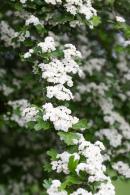Get Additional 5% Off 1st Order
Viburnum Lantana Wayfaring Tree
1. Add items to basket
2. Go to the basket
3. Enter your postcode in Delivery Price Check
Plant shape: Bush
Pot size: 18 Litres
Hedge Guide: 3 Plants/Mtr
Plant ID: 8330 64
click to view this plant size >Plant shape: Bush
Pot size: 30 Litres
Hedge Guide: 2 Plants/Mtr
Plant ID: 9535 64
click to view this plant size >Viburnum Lantana or Wayfaring Tree
Viburnum Lantana is a large, upright fruiting shrub and one of the best for chalky soil. It’s often found growing wild in the pathway hedgerows of southern England hence its common name the ‘Wayfaring Tree’.
Viburnum Lantana has flexible brown-green stems, that were used historically to tie bundles and bales, and its finely toothed ovate grey-green deciduous foliage turns bright red before falling with the first frosts. In May and June small scented tubular white flowers cluster in a flat-topped spray at the tips of upright branches and give rise to Viburnum Lantana’s other name ‘The Cotton Tree’. These delicate flowers are much loved by pollinators and gradually mature into long rounded red fruits that ripen into black berries during autumn and early winter.
In the autumn months, a wayfaring tree’s bare stems are an attractive place for spider webs and during the winter low sunlight will catch on the frosted twigs.
Height and Spread Of Viburnum Lantana
Wayfaring trees will reach between 2.5-4 metres tall and 2.5 to 4 metres wide but shrubs can be kept to preferred height and spread with regular clipping.
How Hardy Are Viburnum Lantana
The Wayfaring Tree is a hardy plant that’s tough enough to withstand UK weather conditions. It will grow in colder parts of the UK down to sub-zero temperatures, enjoys all soil conditions, and is drought tolerant once established.
How To Use Viburnum Lantana
Because it’s a hardy flowering and fruiting shrub Viburnum Lantana is a perfect ‘no-effort’ shrub for woodland and wildlife gardens. Plant wayfaring shrubs at the back of a border for height and colour, or choose them for wildlife-friendly mixed country hedging. It’s best to place them 30 cm apart for a dense hedge. If you have chalky, limestone soil Viburnum Lantana is one of the few shrubs that will thrive there.
The wayfaring tree can also be grown as an interesting stand-alone specimen tree if the leader stem is left uncut.
How To Care For Viburnum Lantana
Viburnum Lantana will grow in most conditions except waterlogged ground. It thrives in chalky soil but will manage in most gardens including exposed situations, however, the flowers, fruits, and foliage will fall faster in consistently strong winds.
Once planted it’s important to water a cotton tree regularly until it’s established. A good thick layer of mulch around the base during spring locks in moisture and provides nutrients for a healthy season of growth.













